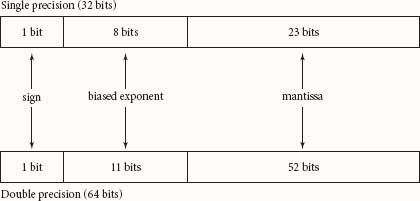APPENDIX E
Representing Floating-Point Numbers
IEEE 754, a specification accepted worldwide and used by the Java language, defines how to represent floating-point numbers in binary numbers. Single-precision floating-point numbers use 32 bits of memory, and double-precision floating-point numbers use 64 bits.
Here is how single- and double-precision floating-point numbers are represented:

The leftmost bit stores the sign of the floating-point number; a 0 indicates a positive number, while a 1 indicates a negative number.
To represent the exponent of the number, which can be positive or negative, each representation stores a positive, biased exponent, ...
Get Java Illuminated, 3rd Edition now with the O’Reilly learning platform.
O’Reilly members experience books, live events, courses curated by job role, and more from O’Reilly and nearly 200 top publishers.

